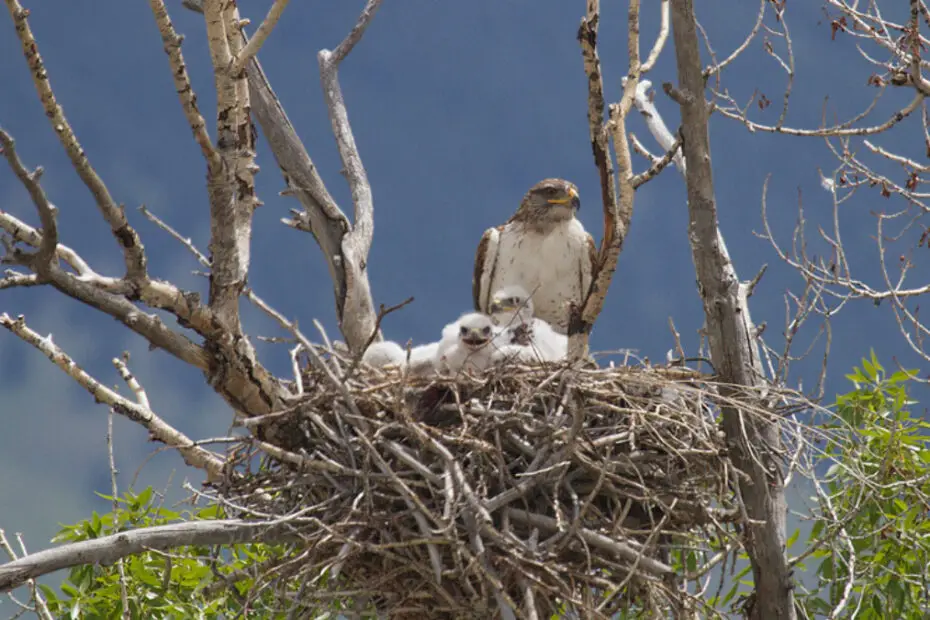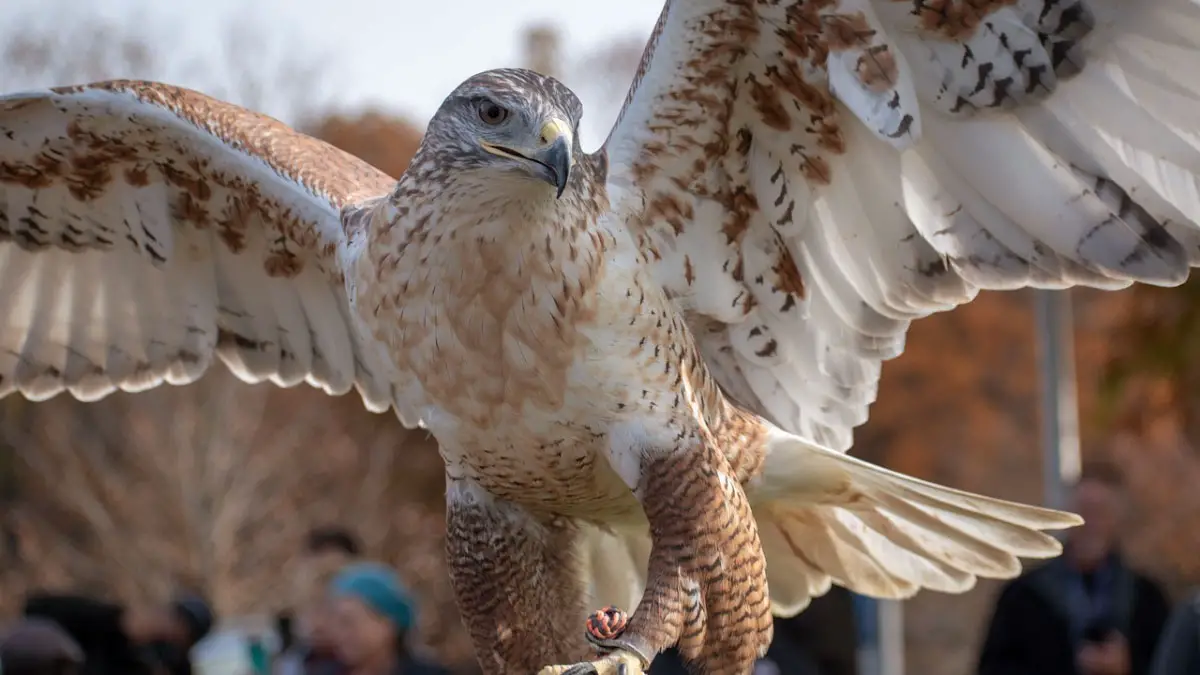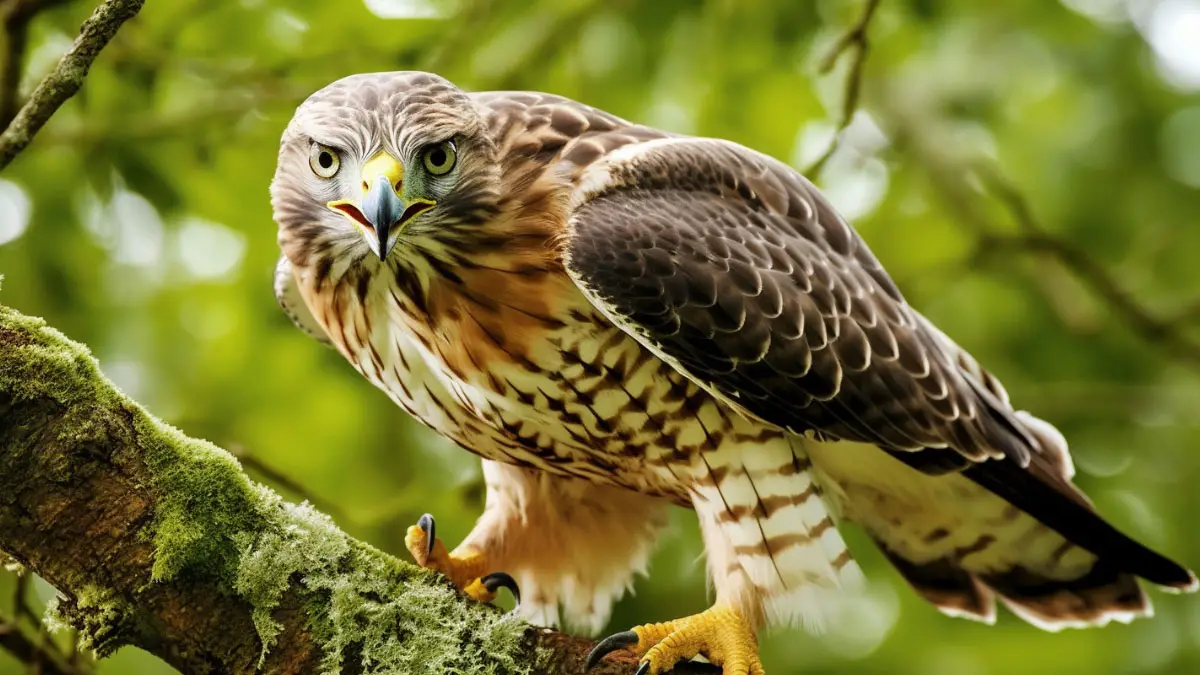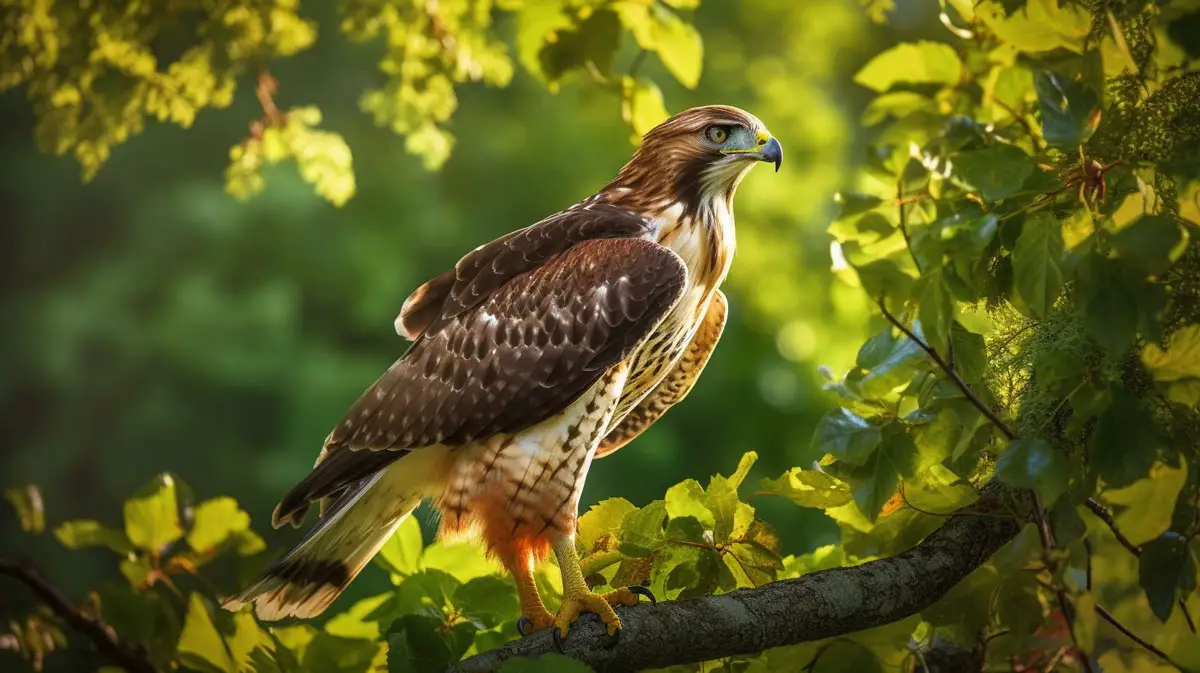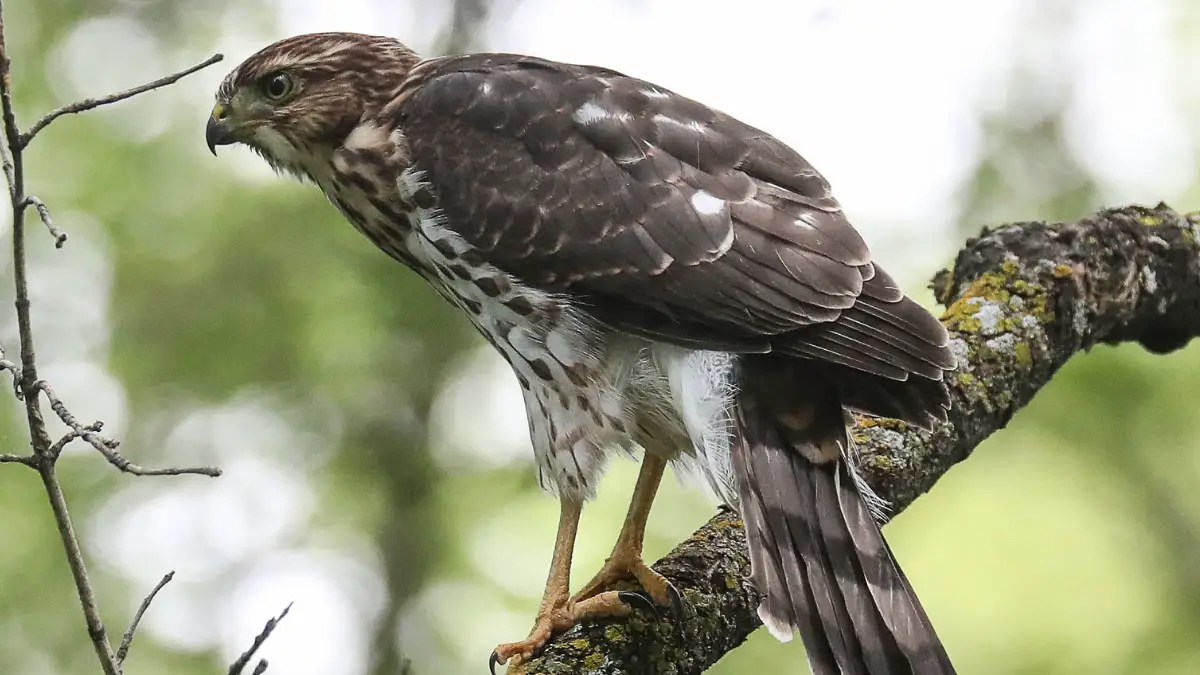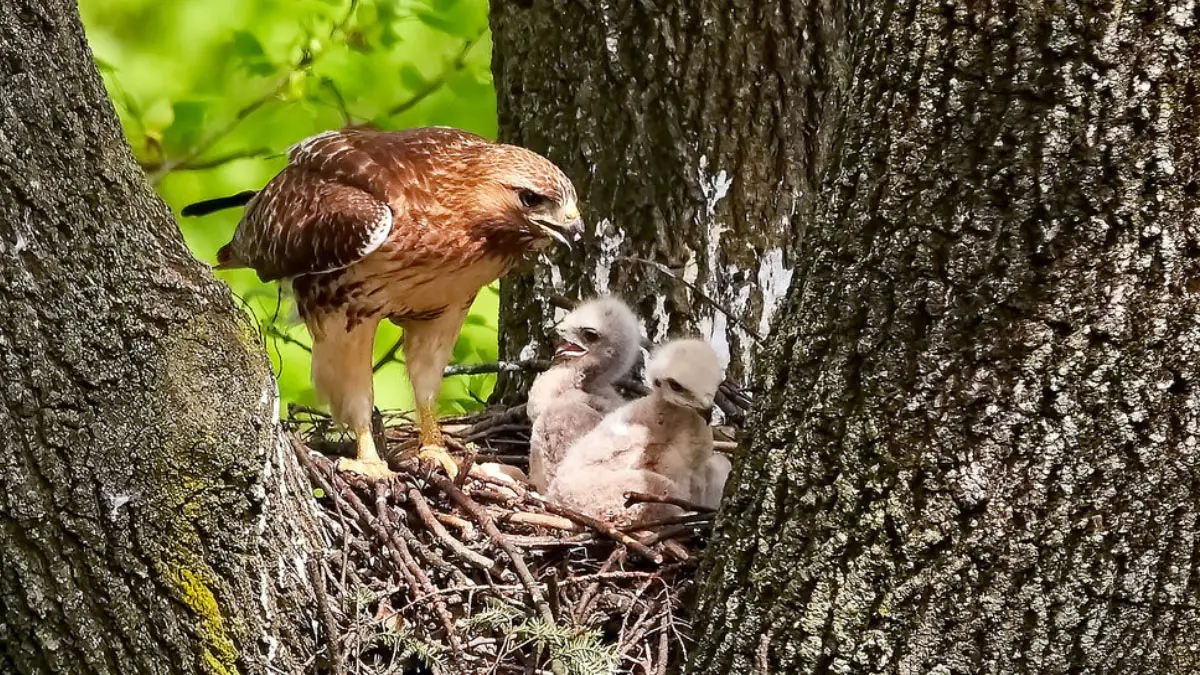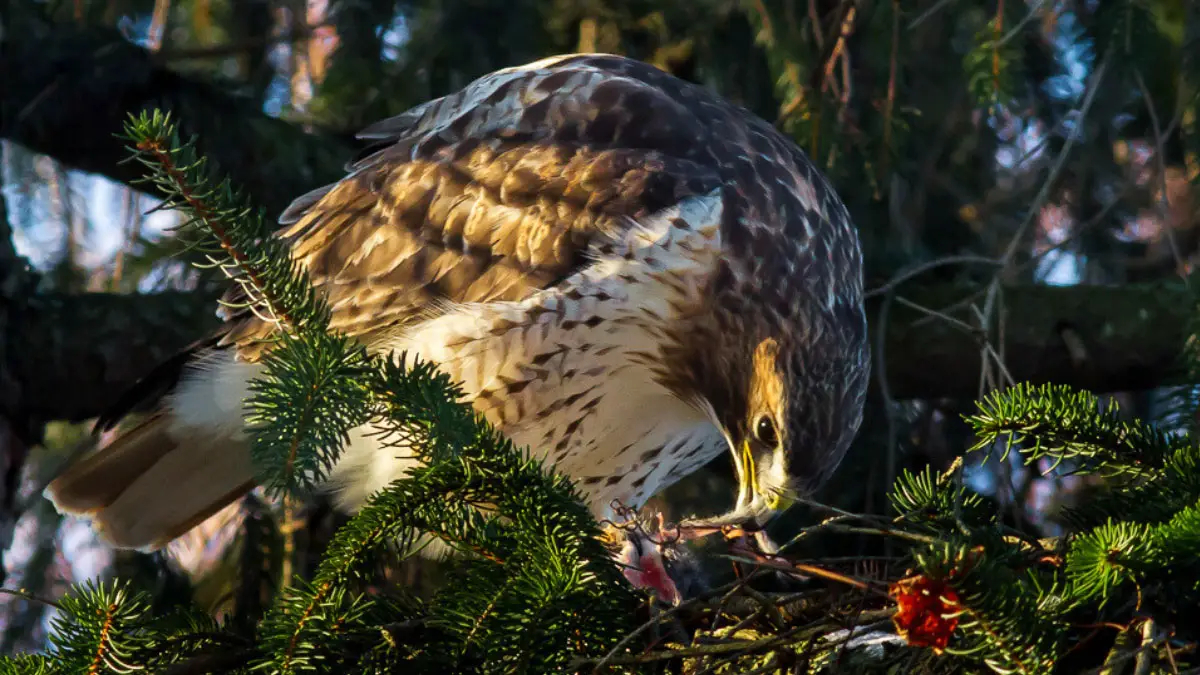Hawks are birds of prey that are found in all continents except Antarctica. There are over 200 species of hawks in the world, and most of them have their young ones in nests.
Hawks build their nests on tall trees, like yellow and white birch and pine trees. Some species, like the Red-tailed hawk, build their nests in trees and cliff substrates and use various stick types.
It’s crucial for any bird enthusiast or researcher to be interested in learning about hawks’ nesting behavior. These are because these behaviors differ across species in both nest building and even the material used.
The article provides a guide on Hawks building their nests and answering the questions like, why, when, and where they build them. There is also information on how they build their nests and how successful and effective these nests are. Therefore, read on.
Why Do Hawks Build Nests?
As we mentioned already, hawks build nests. But what are the purposes of building their nests?
Nests are very important structures to most birds who build nests, hawks included. For one, egg-laying takes place in nests for security provided by materials used in the building. Incubation also happens in the nests, and the lining materials help them retain their heat.
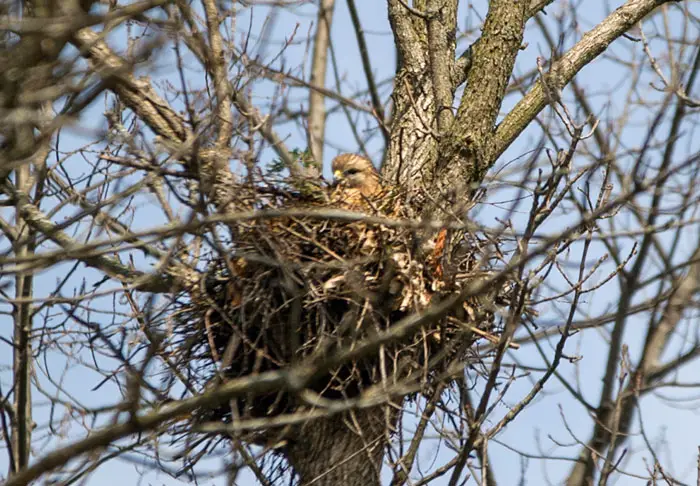
Hawks also live in nests until their young ones grow to an age. The breeding pair only leaves the nest to search for food for their nestlings and return to spend the night. They can spend over two months in the nest, after which the young are weaned and can hunt independently.
Relationship Between Nesting and Territorial Behavior
During the reproduction season, hawks must secure an area to build a nest. Since not all species are social, various hawks may engage in territorial fights. Often these fights begin with a screeching warning, and the trespassing hawk is attacked if it doesn’t leave.
However, territoriality during the nesting season is not in all species. Some, like the Harris’s Hawk and Swainson’s Hawk, can build their nests near each other. Some may even help each other build their nests and brood the eggs during the season.
Significance of Nest-Building to Mate Selection
When a male hawk becomes of mating age, usually about three years, they choose a mate to breed with. However, before they pair, males in most species must first secure a nesting area.
After securing a breeding area where they can build a nest, the hawk calls to advertise the location to potential mates.
Hawks engage in various courtship rituals, including aerial displays, where sometimes they interlock their talons while diving. Some male hawks sometimes provide the female with prey to entice her. Once they pair, in most species, the female selects a suitable nesting point then they both build it.
How Do Hawks Nesting Behaviors Compare to Other Raptors?
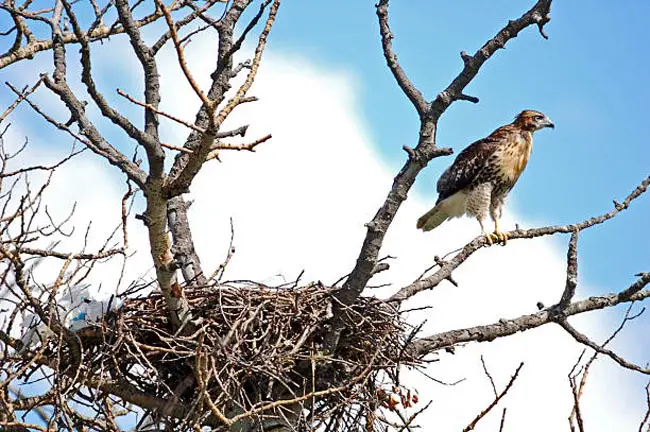
Hawks nesting behavior, especially their nest-building location, is much like that of other raptors, like Red kites. Both build the nest on a main fork or a limb on a high point of a tree. However, red kites may build over other animals’ nests, like old squirrels, which hawks don’t.
A hawk’s breeding behavior differs from harriers, who build their nests on the ground. However, like falcons, they may make their nests on cliffs.
When Do Hawks Build Nests?
Timing is a crucial factor for hawks when building or repairing their nests. Most species build their nests in late winter to early spring, usually between February and March. The nest building usually begins a few weeks before the birds mate to be ready when egg production starts.
However, some species, like Harris’s hawks, may build their nests through June. Ferruginous hawks begin their nest construction in April, while the Broad-winged hawks nest through mid-May.
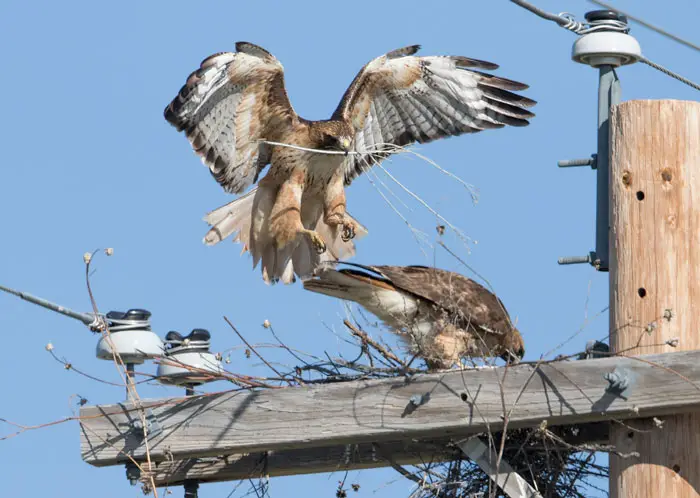
Factors Influencing Nest-Building Time
So, when do hawks build their nests? Several factors determine the time the hawks construct their nest building. They include
1. Weather Condition
Hawks can only build their nest when the weather conditions are favorable. During winter months, the bird cannot construct the nest and have to wait until spring. Climate change is known to affect nest-building time, as birds have to wait through prolonged winters to begin.
2. Food Availability
Hawks are also comfortable nesting when there is enough food for them and their young ones. Food availability is among the reasons the birds wait for spring when prey animals are plenty as plants begin to grow from winter.
3. Breeding Cycles
Most hawk species only breed only once per year, which is usually in spring. This breeding cycle allows them to choose the ideal time to build their nests.
Differences in Nesting Behavior Among Hawk Species
Red-tailed and Coopers’ Hawks build their nest between February and March, and Broad-winged hawks build theirs in May. Also, some species, like Harris’ Hawks, breed two to three times annually, while most of the others only brood once.
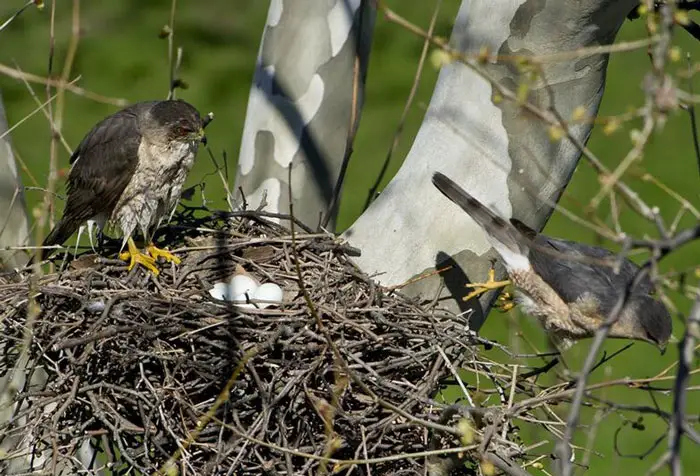
The Relationship Between Nesting Behavior and Migratory Patterns
Among the reasons some birds are late in breeding is because of their migration patterns. Broad-winged hawks migrate to the overwintering grounds in Central and South America. Swainson’s hawks in North America also migrate to South America.
Migration is one of the reasons these birds build their nests in April and May, while other non-migratory birds may start as early as February.
Where Do Hawks Build Nests?
Most hawk species nesting sites are on trees, usually on the main fork or limb. They choose the highest trees in an area, mainly for better surveillance and safety against predators and human interference.
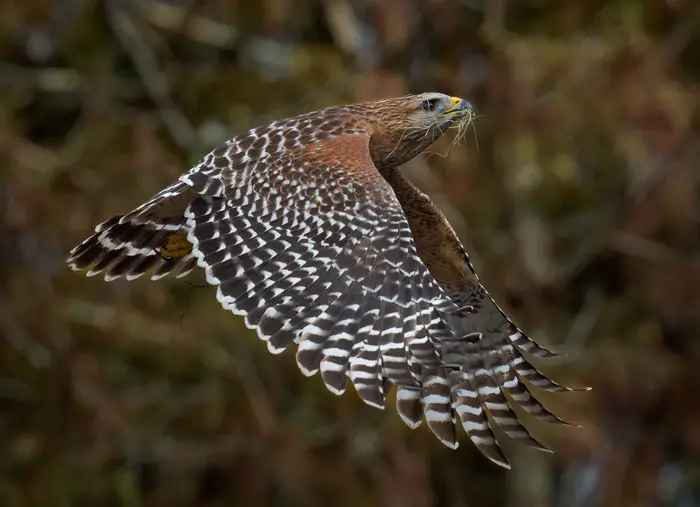
Some species also build their nest on cliff ledges, Red-tailed, Harris’s, and Ferruginous being among them. Some hawk nesting sites are in tall structures, like buildings, a common habit for hawks in urban and suburban habitats.
Types of Habitats Preferred by Hawks
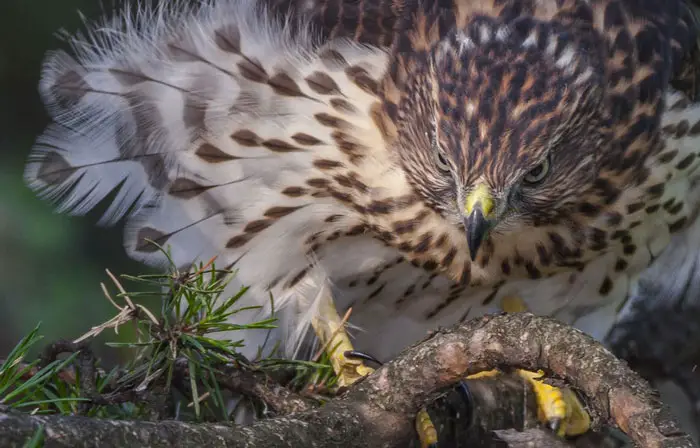
Different hawk species differ in habitat preferences when it comes to nesting.
- Sharp-shinned hawks prefer the top of pine, spruce, or fir trees, and their nests are usually under dense forest cover.
- Cooper hawks prefer deciduous or evergreen forests and sometimes suburban and urban environments.
- Red-tailed hawks build their nests in crowns of tall valley oak or blue oak trees. They can also nest in cliffs, giant cacti, and tall buildings.
- Harris’s hawks can build their nests on mesquite, pine, eucalyptus, and palm trees. They also nest in saguaro cacti and cliffs.
- Ferruginous hawks can nest in a lone tree, cliff, boulder, shrub, outcrop, and sometimes haystack. They can also nest on the ground on slopes and hill crests.
- Broad-winged hawks favor large deciduous or coniferous trees on the branches.
- Swainson’s hawks often nest almost at the top of solitary trees or along a stream. They can also build on the ground, shrubs, or cliff edges.
What Determines an Ideal Nesting Site?
For a nesting site to be suitable for a hawk, it must have various characteristics. For one, an ideal nesting site is in a safe spot, which is why some prefer tall trees or cliff edges. The safety is from predators and human interactions.
Another characteristic is the nearness to a food source, which is crucial to raise their young. Food availability is among the reasons hawks living in urban areas prefer to nest in buildings near their usual food sources. Red-tailed hawks select locations near fields and lakes that act as their food sources.
Hawks Nesting Sites Conservation Improves Nesting Activities
With the increased human activities, most traditional hawk nesting sites are interfered with. Humans sometimes cut down trees used for nesting or often visit nesting sites, which makes the hawks uncomfortable breeding there.
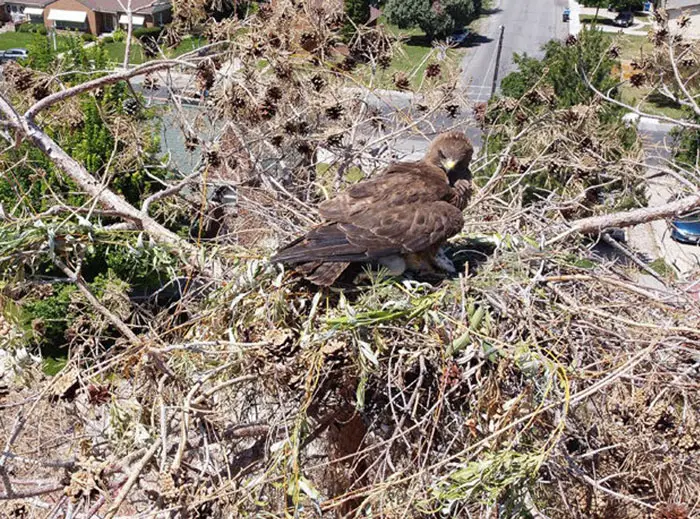
However conservation of the nesting sites improves the nesting activities. Human interactions with the nesting area are reduced during this period, allowing them to nest peacefully.
Also, structures like buildings, powerline poles, and radio towers have provided hawks with nesting sites. Research shows that Red-tailed hawks in urban centers can have a nesting success of up to 86%.
How Do Hawks Build Nests?
Hawks build their nest using various materials and several nest-building techniques, which vary with species. However, most species use sticks and twigs, and some line the inside with greenery.
Also, some species don’t build new nests annually instead, they refurbish the old ones. The male usually brings the materials while the female does the construction. However, in some species, both genders participate in nest-building.
What Materials Do Hawks Use to Build Nests?
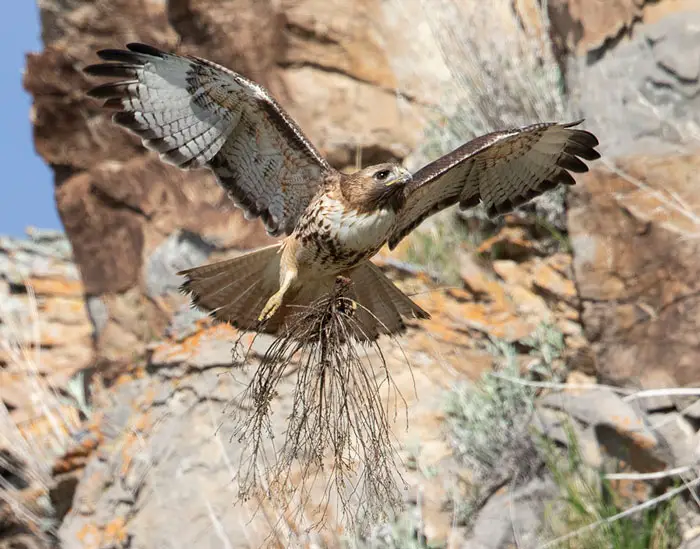
As mentioned above, hawks use several materials to build their nests. However, some materials are used more often than others across the species. Some of the materials used by hawks to build nests include the following:
- Sticks
- Twigs
- Grass
- Bark
- Stems
- Feathers
- Corn husks
- moss
- Greenery
- Debris items, rope, wires, plastic, bones, and metal
Ferruginous and Swainson’s hawks are among the species that use several types of debris on their nests. Broad-winged hawks line the inside of their nests with corn husks and feathers for extra softness.
Sticks, twigs, and barks are used to strengthen the nest, while softer materials line the inside. Most hawk nests are open and wide, and some may be as large as 1.2 meters (47 inches.)
Techniques Used by Hawks in Nest Construction
Hawks use various techniques to construct their nests depending on the species. With birds only using their beaks as their tools, they construct steady nests to breed their young. So how do hawks build nests?
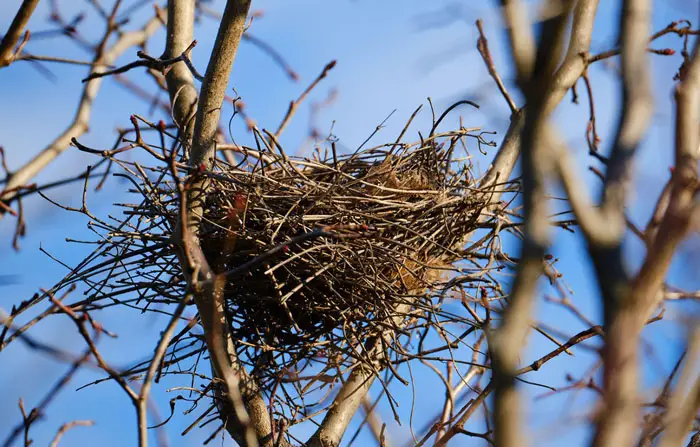
1. Weaving
One of the techniques used by the hawk is weaving, where they fit nesting materials at right angles from each other. This method is common when the bird wants to build a deep nest with longer sides.
The bird uses its beak to line some sticks vertically and then lines others horizontally. They repeat the sequence until they cover the whole nest and then line the inner materials.
2. Interlocking
Another technique is interlocking, where the bird interlocks weaving materials to create a stronger bond. This method is used when constructing the base, which needs to be firm.
3. Platform Building
Platform building is another technique where the bird creates a rounded nest platform with a cavity in the center. The bird may create these types of nests on a flat platform. These platforms are usually man-made by bird enthusiasts or those who love birdwatching.
But how long does it take for hawks to build their nests? Most hawks take up to two weeks to complete their nests. Refurbishing an old nest may be done sooner, within a week. The time varies with material availability as some are corrected further from the nest.
Factors that Determine Hawk Nest Size
Nest sizes differ with hawk species, and the common determining factor is the size of the hawk. Larger hawk species tend to build larger nests that can accommodate the pair and their soon-to-be-born chicks.
Social hawks living with their young from a previous year may also enlarge their nests to provide more room. Also, refurbishing a nest makes it bigger, especially if used for more than three seasons.
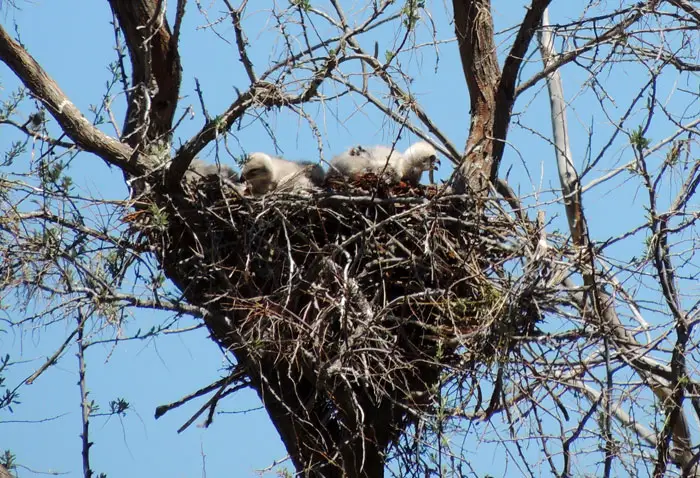
Nesting Success and Parental Care
Nesting success is usually determined by the number of eggs that hatch. If the number of hatched birds is more than that of the eggs lost, it’s considered a success.
Around 74% of Cooper’s hawk eggs hatch, meaning at least three of the four eggs hatch. Their clutch size is usually four eggs. In research in Wisconsin, urban and suburban red-tailed hawks averaged 80.1% nesting success.
Factors That Influence Nesting Success
Various factors determine the nesting success of hawks, including-
1. Predation
Despite the hawks sitting on the top of the food chain, their eggs are in threat of predation. Snakes, raccoons, and sometimes foxes prey on their eggs, decreasing the nesting success.
2. Habitat destruction
Human activities like deforestation and interference with the nest often affect the nesting success.
3. Disease
Like most birds, hawks are prone to diseases, mostly caused by parasites, like trichomonas gallinae and Leucocytozoon toddi. These parasites, especially in parenting pairs, can reduce nesting.
Role of Parental Care in Hawk Offspring
Parental care is crucial and determines the nesting success. Like most bird chicks, the hatchlings feed through the beak-to-beak method, where the mother regurgitates food to their mouth.
Without this crucial step, the chick’s survival is in jeopardy, and it may soon die. Also, before their feathers grow, they depend on their parents for heat.
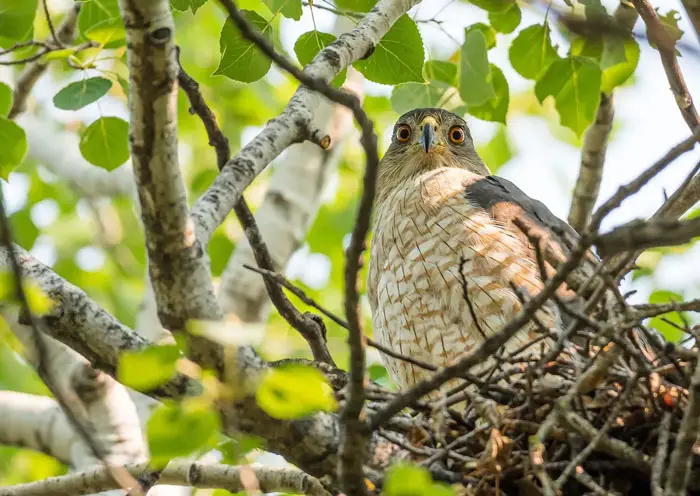
Effects of Conservation on Nesting Success
Various conservation efforts help increase nesting success. For instance, in known hawk breeding areas, human activities should be reduced during the breeding time to allow nesting activity.
Also, people providing nest platforms for hawks has contributed to the nesting success.
Conclusion
Hawks build nests mostly to breed their young ones. They build their nests in late winter to early spring, but some migratory ones may nest late in the spring. Most Hawk species make their nest on trees and cliffs, but some also build them on cacti or the ground.
Hawks use various materials to make their nests and weave them together using their beaks. Habitat destruction and predation are among the factors that determine nesting success.
Whether your reason is for a study or general knowledge, understanding the nesting behavior helps you determine how to help them. This includes habitat conservation and also creating a nest structure, like a platform, where they can build their nest.
While the guide had covered much information on the hawks’ nesting activities, they’re always more you can read. Read official research papers, websites, and forums for more information.
